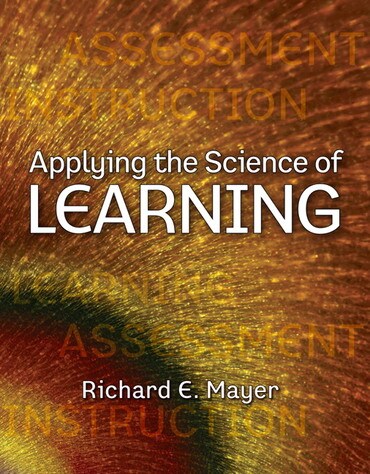
Applying the Science of Learning, 1st edition
Title overview
- A concise and concentrated view of the field that covers the foundational ideas in learning, instruction, and assessment without overwhelming students or wasting words.
- A modular, multimedia approach organizes course material into two-page units with specific objectives, helpful graphics, and a welcoming design that helps readers organize and understand each concept.
- An emphasis on clear writing and concrete ideas makes learning easier for readers, especially by providing vocabulary definitions and specific examples.
- A personal and friendly tone instead of a formal, academic style make this book easier and more enjoyable to read. While few academic references clutter the text, key references and suggested readings are provided at the end of each section.
Table of contents
Preface
Introduction
1. The Big Three: Learning, Instruction, Assessment
2. Rationale for Applying the Science of Learning
3. What Is Applying the Science of Learning?
4. Historical Overview of the Relation Between the Science of Learning and the Science of Instruction
5. Viewing the Relation Between the Science of Learning and the Science of Instruction as Overlapping Goals
Suggested Readings and References
How Learning Works
1. What Is Learning?
2. What is the Science of Learning?
3a. What Changes: Behavior or Knowledge?
3b. What Changes: General or Specific Transfer?
4. How Learning Works: Three Metaphors of Learning
4a. A Closer Look at Response Strengthening: Thorndike’s Law of Effect
4b. A Closer Look at Information Acquisition: Ebbinghaus’ Learning Curve
4c. A Closer Look at Knowledge Construction: Bartlett’s Assimilation to Schema
5. How Learning Works: Three Principles from the Learning Sciences
5a. A Closer Look at Dual Channels: Paivio Concreteness Effect
5b. A Closer Look at Limited Capacity: Miller’s Magic Number 7
5c. A Closer Look at Active Learning: Wittrock”s Generative Processes
6. How Learning Works: A Cognitive Model of Learning
6a. Three Memory Stores in Meaningful Learning
6b. Three Cognitive Processes in Meaningful Learning
7. The Mighty Ms: Motivation and Metacognition
7a. Motivation to Learn
7b. How Motivation Works
7c. Metacognition in Learning
8. Learning in Subject Areas
9. Eight Things We Know About Learning from Word Lists
References and Suggested Readings
How Instruction Works
1. What Is Instruction?
2. What Is the Science of Instruction?
3. What Is an Instructional Objective?
3a. Three Levels of Instructional Objectives
3b. Five Kinds of Knowledge in Instructional Objectives
3c. Six Kinds of Cognitive Processes in Instructional Objectives
4. How Instruction Works: Three Demands on Cognitive Capacity
5. How Instruction Works: Three Instructional Scenarios
6. Twelve Instructional Design Principles for Lesson Learning
6a. Evidence-Based Principles for Reducing Extraneous Processing
6b. Evidence-Based Principles for Managing Essential Processing
6c. Evidence-Based Principles for Fostering Generative Processing
7. Eight Instructional Design Principles for Effective Studying
7a. Evidence-Based Principles for Studying by Practicing
7b. Evidence-Based Principles for Studying by Generating
8. How to Guide Cognitive Processing During Learning
8a. Instructional Techniques for Selecting
8b. Instructional Techniques for Organizing
8c. Instructional Techniques for Integrating
9. Three Popular But Questionable Principles
10a. How Active Teaching Methods Can Go Wrong
10b. Two Kinds of Active Learning
References and Suggested Readings
How Assessment Works
1. What Is Assessment?
1a. Three Functions of Assessments
2. What Is the Science of Assessment?
2a. Using Instructional Objectives in Assessment
2b. How to Construct a Useful Assessment Instrument
3. What Is Research on Instructional Effects?
3a. What Works? Using Randomized Controlled Experiments
3b. When Does It Work? Using Factorial Experiments
3c. How Does It Work? Using Observational Analysis
4. A Closer Look at Experiments
4a. Using Effect Size to Assess Instructional Effects
4b. Six Reasons for No Difference Between the Treatment and Control Groups
5. How to Assess Learning Outcomes
5a. Two Ways to Measure Learning Outcomes
5b. Three Kinds of Learning Outcomes
6a. A Closer Look at Meaningful Versus Rote Learning: Wertheimer’s Parallelogram Lesson
6b. A Closer Look at Assessment of Learning Outcomes: How Much or What Kind?
7. Broadening the Domain of Assessment
8. A Closer Look at Broadening the Domain of Assessment: Attribute Treatment Interactions
8a. Attribute Treatment Interactions Involving Prior Knowledge
9. What Can Go Wrong with Assessments?
References and Suggested Readings
Epilogue
About the Author
Glossary
Author Index
Subject Index
Author bios
Richard E. Mayer is Professor of Psychology at the University of California, Santa Barbara. His research interests include educational and cognitive psychology. He received the E. L. Thorndike Award for career achievement in educational psychology and the Distinguished Contribution of Applications of Psychology to Education and Training Award from the American Psychological Association. He is the author of numerous publications and 23 books, including Multimedia Learning (Cambridge, 2009), Learning and Instruction (Prentice Hall, 2008), E-Learning and the Science of Instruction (Pfeiffer, 2008) with Ruth Clark.